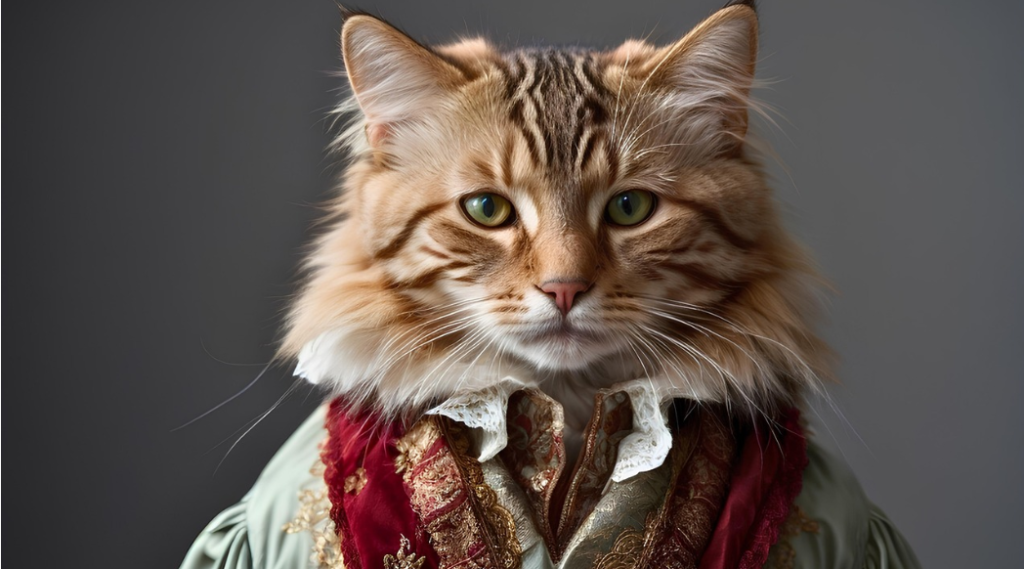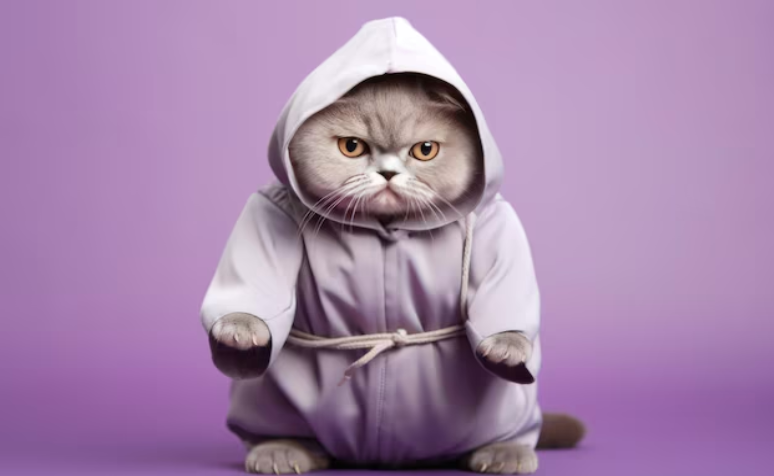A onesie for your cat may seem like a quirky and unconventional accessory, but it can serve multiple practical purposes, including providing warmth, reducing shedding, and even helping with certain medical or post-surgery recovery needs. Whether you’re looking for a cat onesie for Halloween, for health purposes, or just for fun, one of the most critical factors to consider is choosing the right size. So, what size onesie for cat?
To find out the what size collar for an Affenpinscher, ensure you measure your dog’s neck correctly for a perfect fit.
A onesie that’s too tight will cause discomfort, while one that’s too loose won’t stay in place. This comprehensive guide will help you determine the correct size onesie for your cat, providing tips on measuring, fitting, and considerations for different cat breeds and needs.
Blog Highlights
ToggleWhy Does Your Cat Need a Onesie?
Before diving into sizing, let’s first explore why a onesie might be useful for your cat. While it may seem like a novelty, there are several practical reasons to invest in a cat onesie:

1. Medical Recovery
Cats that have undergone surgery (such as spaying, neutering, or dental surgery) may benefit from wearing a onesie. It can help prevent them from licking, scratching, or biting at stitches or wounds. Medical onesies are often made of soft, breathable fabric to ensure comfort during recovery.
2. Warmth and Comfort
For hairless breeds like the Sphynx, a onesie can provide warmth during cooler months. Similarly, cats with thin or short coats may need extra insulation in the winter.
3. Shedding Control
Some cats are heavy shedders, and a onesie can help contain the fur, making it easier to clean up your home.
4. Fashion and Fun
Whether for a special occasion like Halloween or simply to indulge in a cute pet accessory, cat onesies have become popular for their aesthetic appeal and fun factor. For a step-by-step guide on how to wear collar to an Affenpinscher, check out this detailed article to ensure a comfortable and secure fit for your dog.
How to Measure Your Cat for a Onesie
To ensure that your cat’s onesie fits well, accurate measurements are essential. Follow these steps to get the perfect fit:

1. Neck Circumference
Start by measuring your cat’s neck, which is where the onesie will sit. Using a soft measuring tape, wrap it around the base of your cat’s neck, where the collar would normally sit. Make sure you allow a little extra space for comfort—adding 0.5 to 1 inch is a good rule of thumb. Typical neck measurements range from 6 inches for a small kitten to 12–14 inches for a large adult cat.
2. Chest Circumference
Next, measure your cat’s chest, the widest part of their ribcage. Again, use a soft measuring tape and ensure it’s snug but not tight. The chest measurement will help ensure that the onesie doesn’t pinch or constrict your cat’s movement. Typical chest measurements are:
- Small cats: 10–12 inches
- Medium cats: 12–16 inches
- Large cats: 16–20 inches
3. Body Length
Measure your cat from the back of their neck (just behind the ears) to the base of their tail. This will help determine the length of the onesie, ensuring it covers your cat’s body properly without being too long or short. Body length measurements can vary:
- Small cats: 8–10 inches
- Medium cats: 10–12 inches
- Large cats: 12–14 inches
4. Leg Length (If Applicable)
If you are looking for a onesie with sleeves or leg coverings, you’ll need to measure the length of your cat’s legs. Measure from the shoulder joint (for front legs) or hip joint (for back legs) down to where you want the leg of the onesie to end.
5. Weight (Optional)
Though weight alone isn’t a reliable sizing guide, it can give you a rough idea of your cat’s overall size and help you choose between small, medium, or large options, especially for store-bought onesies. Check out the best dog collars for Border Collie to find durable, stylish, and comfortable options for your active dog.
What Size Onesie for Cat | Understanding Onesie Sizes for Cats
Cat onesies typically come in small, medium, and large sizes. While some onesies are adjustable, it’s still important to know your cat’s measurements to make sure you choose the best size. Here’s an overview of typical sizes and what type of cat they fit:

Small Onesie (For Kittens and Small Adult Cats)
- Neck Circumference: 6–8 inches
- Chest Circumference: 10–12 inches
- Body Length: 8–10 inches
- Weight: Typically for cats under 8 pounds (3.5 kg)
This size is ideal for kittens or smaller adult cats, such as the Maine Coon kitten, Russian Blue, or Devon Rex.
Medium Onesie (For Average Adult Cats)
- Neck Circumference: 8–10 inches
- Chest Circumference: 12–16 inches
- Body Length: 10–12 inches
- Weight: Typically for cats between 8–12 pounds (3.5–5.5 kg)
This size fits many average-sized cats, such as the American Shorthair, Bengal, or Siamese. Cats in this range are usually between 9 and 14 inches tall at the shoulder.
Large Onesie (For Larger or Heavier Cats)
- Neck Circumference: 10–12 inches
- Chest Circumference: 16–20 inches
- Body Length: 12–14 inches
- Weight: Typically for cats over 12 pounds (5.5 kg)
This size is suitable for larger cat breeds like the Maine Coon, Norwegian Forest Cat, and Ragdoll. These cats are generally more muscular and longer, so a large onesie provides enough room for comfort.
For guidance on choosing the right collar size for an Airedale puppy, check out this detailed guide.
What Happens if the Onesie is Too Tight?
If you choose a onesie that’s too small, it can lead to several issues that will cause your cat discomfort. Here are some signs that your cat’s onesie is too tight:

1. Restricted Movement
Your cat may have trouble walking, stretching, or grooming. They might also be reluctant to move around or may seem stiff in their movements.
2. Signs of Discomfort
Cats may attempt to scratch at or chew off the onesie if it’s too tight. You might notice your cat pulling at the fabric or appearing agitated.
3. Breathing Problems
If the neck or chest area is too tight, it can restrict airflow, leading to difficulty breathing or shallow breathing. This is especially concerning if the onesie covers the entire torso.
4. Chafing or Redness
Tight onesies can rub against your cat’s skin, causing irritation, chafing, or even sores. Inspect the areas around the legs, neck, and underarms to ensure no redness or irritation. For insights on whether Airedales are good off-leash, explore this comprehensive article.
What Happens if the Onesie is Too Loose?
Conversely, if the onesie is too large, it won’t serve its purpose properly and may even become a hazard. Here’s what can happen with a loose onesie:

1. Falls Off Easily
A loose onesie may slide off, especially if your cat is active or running around. This defeats the purpose of the onesie, especially if it’s meant to help with shedding control or medical recovery.
2. Trips or Tangling
Excess fabric can create tripping hazards. If the onesie is too long or baggy, your cat may accidentally step on the fabric, causing them to stumble or become tangled.
3. Doesn’t Provide Coverage
If the onesie is too loose, it won’t adequately cover your cat’s body, leaving them vulnerable to cold, drafts, or exposing a surgical site that needs protection. Discover the benefits of using a harness by reading this guide on should a Collie wear a harness.
Tips for a Perfect Cat Onesie Fit
Here are some tips to ensure the onesie fits your cat perfectly:

1. Opt for Adjustable Features
Many cat onesies come with adjustable necklines or waistbands, which allow you to tweak the fit. Adjustable straps, Velcro, or stretchy fabric can help achieve a more customized fit for your cat.
2. Choose Soft and Stretchy Fabric
Look for onesies made of breathable, flexible materials like cotton, spandex, or fleece. These fabrics conform to your cat’s body shape while allowing for movement and comfort.
3. Look for Onesies with Easy-to-Fit Legs
If you’re opting for a full-bodied onesie, make sure the legs have enough space. Onesies with built-in stretch or ribbed cuffs around the legs can prevent excess fabric from bunching up.
4. Use Velcro or Snap Closures
Velcro or snap closures along the belly or back can make it easier to get the onesie on and off your cat, ensuring minimal stress during dressing time.
5. Consult Sizing Charts
Always refer to the manufacturer’s sizing chart. Some brands have specific recommendations for different cat breeds or weight ranges, which can guide you toward the best fit.
Conclusion
Choosing the right size onesie for your cat is essential for comfort, function, and safety. Taking accurate measurements—especially for neck, chest, and body length—will help ensure that your cat’s onesie fits snugly without being too tight or too loose.
Whether you’re looking to help your cat recover from surgery, manage shedding, or simply dress them up for fun, there is a perfect size for every cat. Learn if Dachshunds need special collars to provide the right support and comfort for their unique body shape.
Remember, when shopping for a cat onesie, always prioritize your cat’s comfort. If in doubt, it’s better to go for a size larger than one that is too tight. With the right fit, your cat can enjoy their onesie without any issues! Hope so, now you know what size onesie for cat?





